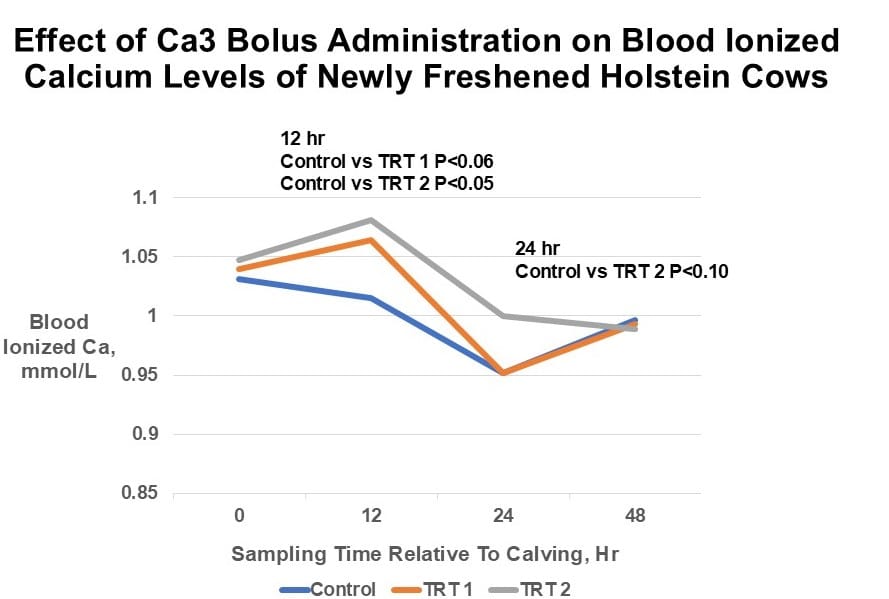Despite the wide-spread adoption of negative-dietary cation-anion differential close-up diets, an estimated 25-50% of newly freshened 2nd lactation and greater cows will experience subclinical hypocalcemia (SCH) or milk fever. The SCH cows (ionized calcium (iCa) levels of <1.0 mmol/L blood) typically experience increased inflammation, reduced milk production, decreased 1st service conception rates and are at greater risk of culling. A research study was conducted to determine if the administration of a Ca3 BioFresh® Bolus immediately after calving would improve blood iCa at 12 hr post-calving and if there are benefits to dosing a 2nd Ca3 bolus 12 hr post-calving.
Study Description
An independent veterinary research company at a 6,000-cow dairy utilizing a close-up ration with a commercial anionic product to maintain urine pH of 6.0 – 6.5. One hundred and five 2nd lactation and greater cows were blocked by parity and then randomly assigned at calving to one of three treatments: (1) negative control with no supplemental calcium at calving (control); (2) one Ca3 bolus within 3 hr of calving (Trt 1); or (3) one Ca3 bolus within 3 hr of calving and a 2nd Ca3 bolus within approximately 12 hr of calving (Trt 2). All cows were enrolled in the study between May 5 and 15, 2022.
Blood samples were collected from the tail vein at approximately 0, 12, 24 and 48 hr post-calving from each cow. Individual cows were considered experimental units, and only cows with blood samples from all four sampling times were included in the statistical analyses.
Study Results and Discussion
At 12 hr, the blood iCa (mmol/L) was greater for Trt 1 (1.06, P<0.06) and Trt 2 (1.08, P<0.05) cows than the control cows (Figure 1). The control and Trt 1 cows were similar for iCa (0.95) at 24 hr; however, the Trt 2 cows, having received the second Ca3 bolus, exhibited a greater (P<0.10) iCa (1.00) than the other two groups. All three treatment groups had similar iCa (0.99) at 48 hr.

Figure 1. Effect of Ca3 BioFresh Bolus Administration on Blood Ionized Calcium Levels of Newly Freshened 2nd Lactation and Greater Holstein Cows.
Conclusions
In this randomized study, administering a Ca3 bolus at calving increased iCa at 12 hr and dosing a second Ca3 bolus at 12 hr increased iCa compared to the control group.
Author: Larry Roth, Ph.D., PAS, Agrarian Solutions
